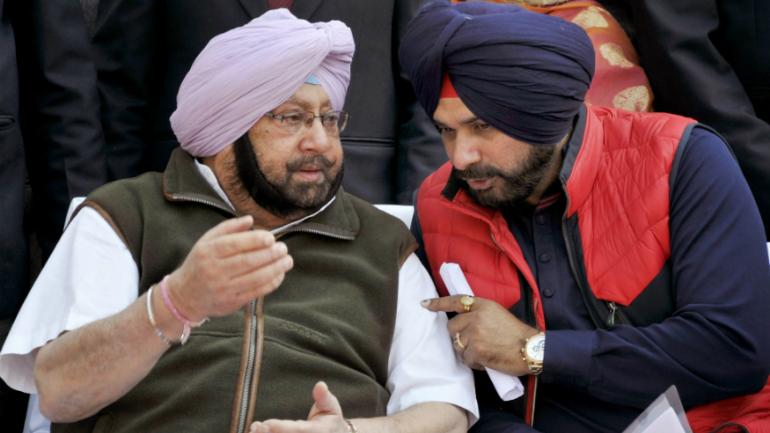
In India where elections form the central institution of democracy and constituent states qualify as mini-republics, it is hardly surprising that the poll-bound states come under intense focus.
Punjab, which goes for elections early next year, however, has been in the news for the last six months. The lingering images of sturdy Sikh farmers firm on the Delhi border, in their tents, while taking on the mighty Modi government over the farm laws, are in fact, going to be ingrained in popular memory for long.
The last week presented another set of developments drawing attention to the political churning in Punjab.
A sizeable number of the dissident Congress leaders were summoned to New Delhi by the party high command to share their grievances against their own government before a three-member All India Congress Committee panel. In action reminiscent of the party’s heydays in the 1970s and 80s, even the state’s powerful two-time chief minister Captain Amarinder Singh, a former Patiala royal, was made to appear.
The Captain reportedly arrived loaded with dossiers prepared against dissidents – some of them his own ministers – who expectedly also had their own set of incriminating papers. As widely reported in the media, the committee has apparently suggested to the Captain to ‘accommodate suitably’ one of the prime dissidents, Navjot Singh Sidhu.
Amarinder Singh (L) and Navjot Singh Sidhu. Photo: PTI/Files
The Captain has also been asked to agree to restructure party organisation and his ministry to ensure wider representation of different sections of the society (read caste, religion, and sub-region, in order). This reminds one of similar assurance given by the high command to another dissident leader, from Rajasthan, last year. However, absolutely nothing happened afterwards.
So what was the purpose of calling the Captain to Delhi?
Was it just aimed at humiliating a powerful chief minister and placate Sidhu, a self-proclaimed loyalist? After all, the Captain had threatened to break the party if not made the chief ministerial candidate ahead of the 2017 elections and also had raised questions in the past over Rahul Gandhi’s ability to lead the party.
The Captain, credited with securing party wins in 2017 and 2019 elections and more recently, the local elections, has consistently refused to yield to the possibility of Sidhu as the state unit chief or as the deputy chief minister. If he yields now, then his leadership would be undermined in the public eye.
The dissident MLAs, in any case, have more pressing worries as they fear the Sikh electorates’ backlash against the perceived inaction of the government against tainted Akali leaders and police officials allegedly involved in the firing incident that took place after the incidents of sacrilege under the Akali regime.
The government has also not been able to check the drug menace or take punitive action against the bigwigs involved. The inaccessibility of the chief minister and his over-dependence on a select set of bureaucrats are complaints that had dogged the Captain even during his earlier stint, from 2002 to 2007.
Protestors raise black flags on their homes to support national black day call given by farmers’ unions on May 26. Photo: Twitter.
One can safely predict that except a cosmetic changes involving a few individuals, this theatrical mode of politics would yield no substantial results other than optics.
SAD-BSP
Punjab also witnessed images of a press conference called by the Shiromani Akali Dal president Sukhbir Badal announcing the party’s long-term alliance with the Bahujan Samaj Party. SAD is facing a deep crisis after having faced successive electoral drubbings, most recently in the local elections. The party (in alliance with the Bharatiya Janata Party) was reduced to 15 (out of 117) and two (out of 13) seats in the 2017 and the 2019 elections.
The somersault of the Akali leadership over the farm bills after initially supporting them when in the NDA has not helped the ‘farmers’ party’ win over the peasantry. The breakup with the BJP has not helped.
Notably, farmers unions had also been unhappy with the Congress due to its earlier support on farm sector reforms but as the party is the main adversary of the BJP and SAD, and also thanks to deft handling by Captain, Congress is on the good books by default.
The BJP is now standing on its own and is unlikely to get an ally. The party is even fearing electoral annihilation, as statements of BJP’s two senior leaders have reflected. However, since its Jana Sangh days, BJP has mainly looked towards urban caste-Hindus and Khatri Sikhs and not the rural Jat peasantry for support.
As an electorally dominant ‘polity-wide’ party, it can always look towards resurrecting itself after the current crisis gets over. To its advantage, it now would have all constituencies to fight rather than only the 23 when in alliance.
So it is SAD which is in deep trouble due to farmers’ anger and the BJP breakup. Would stitching ties with the BSP help the party? For many, the alliance would appear promising considering that 31.9% of the state population belongs to the Scheduled Caste and the BSP, founded by the late Kanshi Ram, a Punjabi, is considered a Dalit party.
Also read: Punjab Assembly Polls: Votes on Mind, Parties Focus Attention on Dalits
Also, last time when in alliance, the BSP had won three seats in the Lok Sabha elections in 1996 and the SAD had won eight.
However, the stark reality is that the said election was contested when the agenda was peace and communal harmony and the SAD was then seen as best placed to bring peace. In the elections held during peaceful times, even a factionalised SAD has always found an ally i.e. in Jana Sangh, CPI, Janata Party, BSP and BJP.
This is because the Congress has always had a coalition support base that cuts across the rural-urban and Hindu-Sikh divides. The Sikhs divided on the basis of region, caste and class have never voted en bloc for SAD. This explains why SAD has of late sought to project itself as the party for ‘Punjab, Punjabi and Punjabiat’. It has also started giving party tickets to Hindu candidates.
As for BSP, the party had made an impressive debut in the 1992 assembly elections (boycotted by SAD) winning 9 seats (16.68% votes). Since then it has steadily gone down in terms of electoral presence in Punjab. The last time when the party could win a solitary assembly seat was 1997. The party polled just 1.5% of votes in 2017, 113 out of the party’s 115 candidates lost their security deposits.
In the recent elections, the impression was that the party was helping out the SAD-BJP combine by taking away Dalit votes which would have otherwise gone to the Congress. In Punjab, the party was inexplicably kept organisationally weak and leaderless by Mayawati.
Shiromani Akali Dal (SAD) President Sukhbir Singh Badal offers sweets to Bahujan†Samaj Party (BSP) Secretary General Satish Chandra Mishra during a joint press conference at the SAD head office in Chandigarh, Saturday, June 12, 2021. Photo: PTI
Catering to politics of ‘presence’, SAD has declared that a Dalit person would be appointed as the deputy chief minister in case the party wins. BJP, which has never got Dalit support, has promised a Dalit chief minister. Would posturing enthuse Dalits to vote for SAD? Also, would the traditional Akali-supporting Jat peasantry owning 96% of the land and having tumultuous class relations with landless Dalits vote for BSP candidates?
This is the reason why most of the 20 constituencies allotted are urban in nature and Hindu dominated, like Amritsar, Mohali, Pathankot, Nawanshahar, Anandpur Sahib, Kartarpur, Jalandhar, Phagwara, and Hoshiarpur, among others. Also, the constituencies are mostly located in and around the Doaba region where there is a large-scale concentration of Dalit communities.
Again, most of these constituencies (12 in total) were earlier allotted to the BJP and so, along with the Congress, it has strong presence in them. So the impression one gets is that the whole exercise, while no more than optics, is slightly more meaningful than the farcical one staged earlier by the Congress.
The grim reality is that the state – reeling under the after-effects of an ill-conceived green revolution, the exodus of industries to the neighbouring states and of rural youth to the west – has been hoping for a credible political alternative in terms of parties and leadership. The rolling back of the farm laws, the taming of the Captain, cosmic changes in the government or ‘coming together’ of the parties is hardly going to usher in a ‘new day in politics’ of Punjab.
Ashutosh Kumar is professor, department of political science, Panjab University, Chandigarh.

